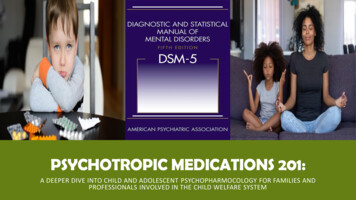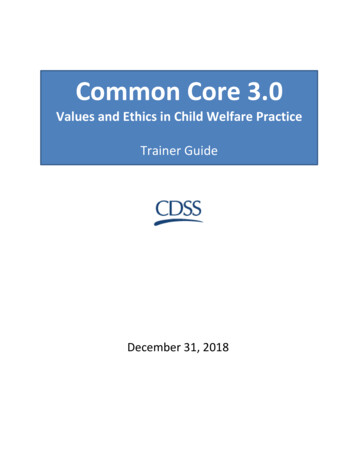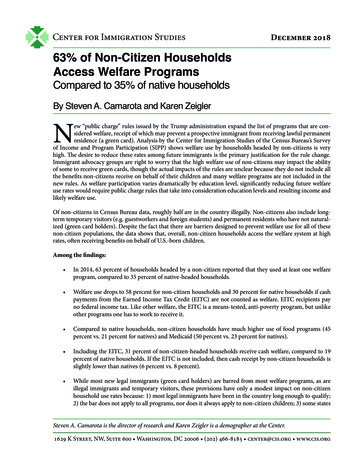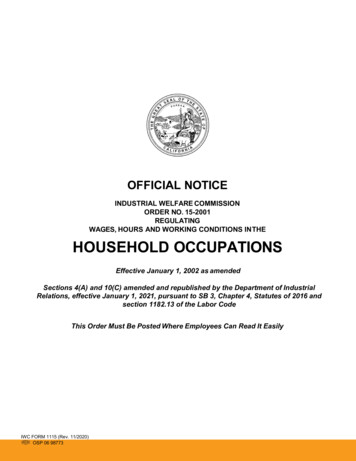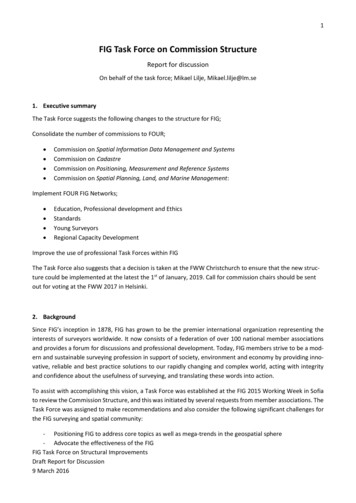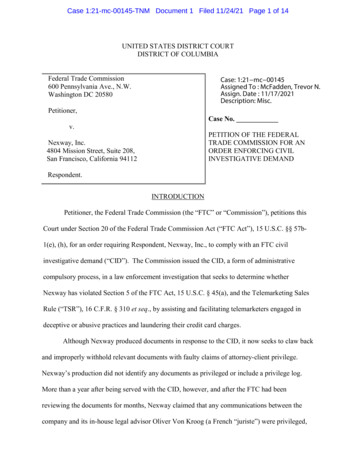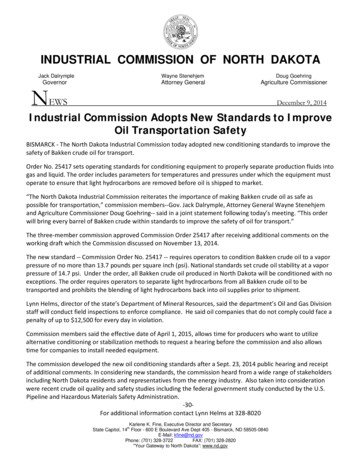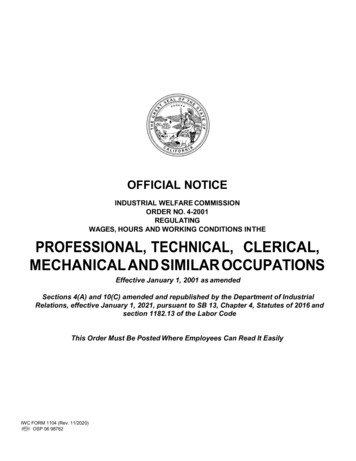
Transcription
OFFICIAL NOTICEINDUSTRIAL WELFARE COMMISSIONORDER NO. 4-2001REGULATINGWAGES, HOURS AND WORKING CONDITIONS INTHEPROFESSIONAL, TECHNICAL, CLERICAL,MECHANICAL AND SIMILAR OCCUPATIONSEffective January 1, 2001 as amendedSections 4(A) and 10(C) amended and republished by the Department of IndustrialRelations, effective January 1, 2021, pursuant to SB 13, Chapter 4, Statutes of 2016 andsection 1182.13 of the Labor CodeThis Order Must Be Posted Where Employees Can Read It EasilyIWC FORM 1104 (Rev. 11/2020)OSP 06 98762
Please Post With This Side ShowingOFFICIAL NOTICEEffective January 1, 2001 as amendedSections 4(A) and 10(C) amended and republished by the Department of IndustrialRelations, effective January 1, 2021, pursuant to SB 3, Chapter 4, Statutes of 2016 andsection 1182.13 of the Labor CodeINDUSTRIAL WELFARE COMMISSIONORDER NO. 4-2001REGULATINGWAGES, HOURS AND WORKING CONDITIONS IN THEPROFESSIONAL, TECHNICAL, CLERICAL, MECHANICAL AND SIMILAROCCUPATIONSTAKE NOTICE: To employers and representatives of persons working in industries and occupations in the State of California:The Department of Industrial Relations amends and republishes the minimum wage and meals and lodging credits in the IndustrialWelfare Commission’s Orders as a result of legislation enacted (SB 3, Ch. 4, Stats of 2016, amending section 1182.12 of the CaliforniaLabor Code), and pursuant to section 1182.13 of the California Labor Code. The amendments and republishing make no other changesto the IWC’s Orders.1. APPLICABILITY OF ORDERThis order shall apply to all persons employed in professional, technical, clerical, mechanical, and similar occupationswhether paid on a time, piece rate, commission, or other basis, except that:(A) Provisions of Sections 3 through 12 shall not apply to persons employed in administrative, executive, or professionalcapacities. The following requirements shall apply in determining whether an employee’s duties meet the test to qualify for anexemption from those sections:(1) Executive Exemption. A person employed in an executive capacity means any employee:(a) Whose duties and responsibilities involve the management of the enterprise in which he/she is employed or of acustomarily recognized department or subdivision thereof; and(b) Who customarily and regularly directs the work of two or more other employees therein; and(c) Who has the authority to hire or fire other employees or whose suggestions and recommendations as to thehiring or firing and as to the advancement and promotion or any other change of status of other employees will be givenparticular weight; and(d) Who customarily and regularly exercises discretion and independent judgment; and(e) Who is primarily engaged in duties which meet the test of the exemption. The activities constituting exempt work andnon- exempt work shall be construed in the same manner as such items are construed in the following regulations under theFair Labor Standards Act effective as of the date of this order: 29 C.F.R. Sections 541.102, 541.104-111, and 541.115-116.Exempt work shall include, for example, all work that is directly and closely related to exempt work and work which is properlyviewed as a means for carrying out exempt functions. The work actually performed by the employee during the course of theworkweek must, first and foremost, be examined and the amount of time the employee spends on such work, together with theemployer’s realistic expectations and the realistic requirements of the job, shall be considered in determining whether theemployee satisfies this requirement.(f) Such an employee must also earn a monthly salary equivalent to no less than two (2) times the state minimum wagefor full-time employment. Full-time employment is defined in Labor Code Section 515(c) as 40 hours per week.(2) Administrative Exemption. A person employed in an administrative capacity means any employee:(a) Whose duties and responsibilities involve either:(i) The performance of office or non-manual work directly related to management policies or general businessoperations of his/her employer or his/her employer’s customers; or(ii) The performance of functions in the administration of a school system, or educational establishment orinstitution, or of a department or subdivision thereof, in work directly related to the academic instruction or training carried ontherein; and(b) Who customarily and regularly exercises discretion and independent judgment; and(c) W ho regularly and directly assists a proprietor, or an employee employed in a bona fide executive oradministrative capacity (as such terms are defined for purposes of this section); or(d) Who performs under only general supervision work along specialized or technical lines requiringspecial training, experience, or knowledge; or(e) Who executes under only general supervision special assignments and tasks; and(f) Who is primarily engaged in duties that meet the test of the exemption. The activities constituting exempt workand non- exempt work shall be construed in the same manner as such terms are construed in the following regulationsunder the Fair LaborStandards Act effective as of the date of this order: 29 C.F.R.Sections 541.201-205, 541.207-208, 541.210, and541.215. Exempt work shall include, for example, all work that is directly and closely related to exempt work and work which isproperly viewed as a means for carrying out exempt functions. The work actually performed by the employee during the course—1
of the workweek must, first and foremost, be examined and the amount of time the employee spends on such work, togetherwith the employer’s realistic expectations and the realistic requirements of the job, shall be considered in determining whetherthe employee satisfies this requirement.(g) Such employee must also earn a monthly salary equivalent to no less than two (2) times the state minimumwage for full- time employment. Full-time employment is defined in Labor Code Section 515(c) as 40 hours per week.(3) Professional Exemption. A person employed in a professional capacity means any employee who meets all ofthe following requirements:(a) Who is licensed or certified by the State of California and is primarily engaged in the practice of oneof the following recognized professions: law, medicine, dentistry, optometry, architecture, engineering, teaching, oraccounting; or(b) Who is primarily engaged in an occupation commonly recognized as a learned or artistic profession. For thepurposes of this subsection, “learned or artistic profession” means an employee who is primarily engaged in the performance of:(i) Work requiring knowledge of an advanced type in a field or science or learning customarily acquired by aprolonged course of specialized intellectual instruction and study, as distinguished from a general academic education andfrom an apprenticeship, and from training in the performance of routine mental, manual, or physical processes, or work that is anessential part of or necessarily incident to any of the above work; or(ii) Work that is original and creative in character in a recognized field of artistic endeavor (as opposed towork which can be produced by a person endowed with general manual or intellectual ability and training), and the result ofwhich depends primarily on the invention, imagination, or talent of the employee or work that is an essential part of or necessarilyincident to any of the above work; and(iii) Whose work is predominantly intellectual and varied in character (as opposed to routine mental, manual,mechanical, or physical work) and is of such character that the output produced or the result accomplished cannot bestandardized in relation to a given period of time.(c) Who customarily and regularly exercises discretion and independent judgment in the performance of duties setforth in subparagraphs (a) and (b).(d) Who earns a monthly salary equivalent to no less than two (2) times the state minimum wage for full-timeemployment. Full-time employment is defined in Labor Code Section 515 (c) as 40 hours per week.(e) Subparagraph (b) above is intended to be construed in accordance with the following provisions of federallaw as they existed as of the date of this wage order: 29 C.F.R. Sections 541.207, 541.301(a)-(d), 541.302, 541.306, 541.307,541.308, and 541.310.(f) Notwithstanding the provisions of this subparagraph, pharmacists employed to engage in the practice ofpharmacy, and registered nurses employed to engage in the practice of nursing, shall not be considered exempt professionalemployees, nor shall they be considered exempt from coverage for the purposes of this subparagraph unless they individuallymeet the criteria established for exemption as executive or administrative employees.(g) Subparagraph (f) above shall not apply to the following advanced practice nurses:(i) Certified nurse midwives who are primarily engaged in performing duties for which certification is requiredpursuant to Article 2.5 (commencing with Section 2746) of Chapter 6 of Division 2 of the Business and Professions Code.(ii) Certified nurse anesthetists who are primarily engaged in performing duties for which certification is requiredpursuant to Article 7 (commencing with Section 2825) of Chapter 6 of Division 2 of the Business and Professions Code.(iii) Certified nurse practitioners who are primarily engaged in performing duties for which certification is requiredpursuant to Article 8 (commencing with Section 2834) of Chapter 6 of Division 2 of the Business and Professions Code.(iv) Nothing in this subparagraph shall exempt the occupations set forth in clauses (i), (ii), and (iii) frommeeting the requirements of subsection 1(A)(3)(a)–(d) above.(h) Except, as provided in subparagraph (i), an employee in the computer software field who is paid on an hourly basisshall be exempt, if all of the following apply:(i) The employee is primarily engaged in work that is intellectual or creative and that requires the exerciseof discretion and independent judgment.(ii) The employee is primarily engaged in duties that consist of one or more of the following:—The application of systems analysis techniques and procedures, including consulting with users, to determinehardware, software, or system functional specifications.—The design, development, documentation, analysis, creation, testing, or modification of computer systemsor programs, including prototypes, based on and related to user or system design specifications.—The documentation, testing, creation, or modification of computer programs related to the design of softwareor hardware for computer operating systems.(iii) The employee is highly skilled and is proficient in the theoretical and practical application of highlyspecialized information to computer systems analysis, programming, and software engineering. A job title shall not bedeterminative of the applicability of this exemption.(iv) The employee’s hourly rate of pay is not less than forty-one dollars ( 41.00). The Office of Policy, Researchand Legislation shall adjust this pay rate on October 1 of each year to be effective on January 1 of the following year byanamount equal to the percentage increase in the California Consumer Price Index for Urban Wage Earners and Clerical Workers. 11Pursuant to Labor Code section 515.5, subdivision (a)(4), the Office of the Director-Research, Department of IndustrialRelations, has adjusted the minimum hourly rate of pay specified in this subdivision to be 49.77, effective January 1, 2007. Thishourly rate of pay is adjusted on October 1 of each year to be effective on January 1, of the following year, and may beobtained at es.html or by mail from the Department of Industrial Relations.—2
(i) The exemption provided in subparagraph (h) does not apply to an employee if any of the following apply:(i) The employee is a trainee or employee in an entry-level position who is learning to become proficient in thetheoretical and practical application of highly specialized information to computer systems analysis, programming, and softwareengineering.(ii) The employee is in a computer-related occupation but has not attained the level of skill and expertisenecessary to work independently and without close supervision.(iii) The employee is engaged in the operation of computers or in the manufacture, repair, or maintenance ofcomputer hardware and related equipment.(iv) The employee is an engineer, drafter, machinist, or other professional whose work is highly dependent upon orfacilitated by the use of computers and computer software programs and who is skilled in computer-aided design software,including CAD/CAM, but who is not in a computer systems analysis or programming occupation.(v) The employee is a writer engaged in writing material, including box labels, product descriptions,documentation, promotional material, setup and installation instructions, and other similar written information, either for print or foron screen media or who writes or provides content material intended to be read by customers, subscribers, or visitors to computerrelated media such as the World Wide Web or CD-ROMs.(vi) The employee is engaged in any of the activities set forth in subparagraph (h) for the purpose ofcreating imagery for effects used in the motion picture, television, or theatrical industry.(B) Except as provided in Sections 1, 2, 4, 10, and 20, the provisions of this order shall not apply to any employeesdirectly employed by the State or any political subdivision thereof, including any city, county, or special district.(C) The provisions of this order shall not apply to outside salespersons.(D) The provisions of this order shall not apply to any individual who is the parent, spouse, child, or legally adopted childof the employer.(E) The provisions of this order shall not apply to any individual participating in a national service program, such asAmeriCorps, carried out using assistance provided under Section 12571 of Title 42 of the United States Code. (See Stats. 2000,Ch. 365, amending Labor Code Section 1171.)2. DEFINITIONS(A) An “alternative workweek schedule” means any regularly scheduled workweek requiring an employee to work morethan eight (8) hours in a 24-hour period.(B) “Commission” means the Industrial Welfare Commission of the State of California.(C) “Division” means the Division of Labor Standards Enforcement of the State of California.(D) “Emergency” means an unpredictable or unavoidable occurrence at unscheduled intervals requiring immediate action.(E) “Employ” means to engage, suffer, or permit to work.(F) “Employee” means any person employed by an employer.(G) “Employees in the health care industry” means any of the following:(1) Employees in the health care industry providing patient care; or(2) Employees in the health care industry working in a clinical or medical department, including pharmacistsdispensing prescriptions in any practice setting; or(3) Employees in the health care industry working primarily or regularly as a member of a patient care delivery team; or(4) Licensed veterinarians, registered veterinary technicians and unregistered animal health technicians providing patientcare.(H) “Employer” means any person as defined in Section 18 of the Labor Code, who directly or indirectly, or through an agent orany other person, employs or exercises control over the wages, hours, or working conditions of any person.(I) “Health care emergency” consists of an unpredictable or unavoidable occurrence at unscheduled intervals relating tohealth care delivery, requiring immediate action.(J) “Health care industry” is defined as hospitals, skilled nursing facilities, intermediate care and residential care facilities,convalescent care institutions, home health agencies, clinics operating 24 hours per day, and clinics performing surgery,urgent care, radiology, anesthesiology, pathology, neurology or dialysis.(K) “Hours worked” means the time during which an employee is subject to the control of an employer, and includes allthe time the employee is suffered or permitted to work, whether or not required to do so. Within the health care industry, theterm “hours worked” means the time during which an employee is suffered or permitted to work for the employer, whether or notrequired to do so, as interpreted in accordance with the provisions of the Fair Labor Standards Act.(L) “Minor” means, for the purpose of this order, any person under the age of 18 years.(M) “Outside salesperson” means any person, 18 years of age or over, who customarily and regularly works more than halfthe working time away from the employer’s place of business selling tangible or intangible items or obtaining orders or contracts forproducts, services or use of facilities.(N) “Primarily” as used in Section 1, Applicability, means more than one-half the employee’s work time.(O) “Professional, Technical, Clerical, Mechanical, and Similar Occupations” includes professional, semiprofessional,managerial, supervisorial, laboratory, research, technical, clerical, office work, and mechanical occupations. Said occupations shallinclude, but not be limited to, the following: accountants; agents; appraisers; artists; attendants; audio-visual technicians;bookkeepers; bundlers; billposters; canvassers; carriers; cashiers; checkers; clerks; collectors; communications and soundtechnicians; compilers; copy holders; copy readers; copy writers; computer programmers and operators; demonstrators anddisplay representatives; dispatchers; distributors; door-keepers; drafters; elevator operators; estimators; editors; graphic artstechnicians; guards; guides; hosts; inspectors; installers; instructors; interviewers; investigators; librarians; laboratory workers;machine operators; mechanics; mailers; messengers; medical and dental technicians and technologists; models; nurses;packagers; photographers; porters and cleaners; process servers; printers; proof readers; salespersons and sales agents;—3
secretaries; sign erectors; sign painters; social workers; solicitors; statisticians; stenographers; teachers; telephone, radiotelephone, telegraph and call-out operators; tellers; ticket agents; tracers; typists; vehicle operators; x-ray technicians; theirassistants and other related occupations listed as professional, semiprofessional, technical, clerical, mechanical, and kindredoccupations.(P) “Shift” means designated hours of work by an employee, with a designated beginning time and quitting time.(Q) “Split shift” means a work schedule, which is interrupted by non-paid non-working periods established by the employer,other than bona fide rest or meal periods.(R) “Teaching” means, for the purpose of Section 1 of this order, the profession of teaching under a certificate from theCommission for Teacher Preparation and Licensing or teaching in an accredited college or university.(S) “Wages” includes all amounts for labor performed by employees of every description, whether the amount is fixedor ascertained by the standard of time, task, piece, commission basis, or other method of calculation.(T) “Workday” and “day” mean any consecutive 24-hour period beginning at the same time each calendar day.(U) “Workweek” and “week” mean any seven (7) consecutive days, starting with the same calendar day each week. “Workweek”is a fixed and regularly recurring period of 168 hours, seven (7) consecutive 24-hour periods.3. HOURS AND DAYS OF WORK(A) Daily Overtime - General Provisions(1) The following overtime provisions are applicable to employees 18 years of age or over and to employees 16 or 17years of age who are not required by law to attend school and are not otherwise prohibited by law from engaging in thesubject work. Such employees shall not be employed more than eight (8) hours in any workday or more than 40 hours in anyworkweek unless the employee receives one and one-half (1½) times such employee’s regular rate of pay for all hoursworked over 40 hours in the workweek. Eight (8) hours of labor constitutes a day’s work. Employment beyond eight (8)hours in any workday or more than six (6) days in any workweek is permissible provided the employee is compensated forsuch overtime at not less than:(a) One and one-half (1½) times the employee’s regular rate of pay for all hours worked in excess of eight (8)hours up to and including 12 hours in any workday, and for the first eight (8) hours worked on the seventh (7th) consecutive day ofwork in a workweek; and(b) Double the employee’s regular rate of pay for all hours worked in excess of 12 hours in any workday and for allhours worked in excess of eight (8) hours on the seventh (7th) consecutive day of work in a workweek.(c) The overtime rate of compensation required to be paid to a nonexempt full-time salaried employee shall becomputed by using the employee’s regular hourly salary as one-fortieth (1/40) of the employee’s weekly salary.(B) Alternative Workweek Schedules(1) No employer shall be deemed to have violated the daily overtime provisions by instituting, pursuant to the electionprocedures set forth in this wage order, a regularly scheduled alternative workweek schedule of not more than ten (10) hours perday within a 40 hour workweek without the payment of an overtime rate of compensation. All work performed in any workday beyondthe schedule established by the agreement up to 12 hours a day or beyond 40 hours per week shall be paid at one and one-half(1½) times the employee’s regular rate of pay. All work performed in excess of 12 hours per day and any work in excess of eight (8)hours on those days worked beyond the regularly scheduled number of workdays established by the alternative workweekagreement shall be paid at double the employee’s regular rate of pay. Any alternative workweek agreement adopted pursuant tothis section shall provide for not less than four (4) hours of work in any shift. Nothing in this section shall prohibit an employer,at the request of the employee, to substitute one day of work for another day of the same length in the shift provided by thealternative workweek agreement on an occasional basis to meet the personal needs of the employee without the payment ofovertime. No hours paid at either one and one-half (1½) or double the regular rate of pay shall be included in determining when 40hours have been worked for the purpose of computing overtime compensation.(2) If an employer whose employees have adopted an alternative workweek agreement permitted by this order requires anemployee to work fewer hours than those that are regularly scheduled by the agreement, the employer shall pay the employeeovertime compensation at a rate of one and one-half (1½) times the employee’s regular rate of pay for all hours worked in excessof eight (8) hours, and double the employee’s regular rate of pay for all hours worked in excess of 12 hours for the day theemployee is required to work the reduced hours.(3) An employer shall not reduce an employee’s regular rate of hourly pay as a result of the adoption, repeal ornullification of an alternative workweek schedule.(4) An employer shall explore any available reasonable alternative means of accommodating the religious belief orobservance of an affected employee that conflicts with an adopted alternative workweek schedule, in the manner providedby subdivision (j) of Section 12940 of the Government Code.(5) An employer shall make a reasonable effort to find a work schedule not to exceed eight (8) hours in a workday, inorder to accommodate any affected employee who was eligible to vote in an election authorized by this section and whois unable to work thealternative workweek schedule established as the result of that election.(6) An employer shall be permitted, but not required, to provide a work schedule not to exceed eight (8) hours in aworkday to accommodate any employee who is hired after the date of the election and who is unable to work the alternativeworkweek schedule established by theelection.(7) Arrangements adopted in a secret ballot election held pursuant to this order prior to 1998, or under the rules ineffect prior to 1998, and before the performance of the work, shall remain valid after July 1, 2000 provided that the results ofthe election are reported by the employer to the Office of Policy, Research and Legislation by January 1, 2001, in accordance withthe requirements of subsection (C) below (Election Procedures). If an employee was voluntarily working an alternative workweekschedule of not more than ten (10) hours a day as of July 1, 1999, that alternative workweek schedule was based on an individualagreement made after January 1, 1998 between the employee and employer, and the employee submitted, and the employer—4
approved, a written request on or before May 30, 2000 to continue the agreement, the employee may continue to work thatalternative workweek schedule without payment of an overtime rate of compensation for the hours provided in the agreement.The employee may revoke his/her voluntary authorization to continue such a schedule with 30 days written notice to the employer.New arrangements can only be entered into pursuant to the provisions of this section. Notwithstanding the foregoing, if a healthcare industry employer implemented a reduced rate for 12-hour shift employees in the last quarter of 1999 and desires tore-implement a flexible work arrangement that includes 12-hour shifts at straight time for the same work unit, the employer mustpay a base rate to each affected employee in the work unit that is no less than that employee’s base rate in 1999 immediately priorto the date of the rate reduction.(8) Notwithstanding the above provisions regarding alternative workweek schedules, no employer of employees inthe health care industry shall be deemed to have violated the daily overtime provisions by instituting, pursuant to the electionprocedures set forth in this wage order a regularly scheduled alternative workweek schedule that includes workdaysexceeding ten (10) hours but not more than 12 hours within a 40 hour workweek without the payment of overtimecompensation, provided that:(a) An employee who works beyond 12 hours in a workday shall be compensated at double the employee’sregular rate of pay for all hours in excess of 12;(b) An employee who works in excess of 40 hours in a workweek shall be compensated at one and one-half (11/2)times the employee’s regular rate of pay for all hours over 40 hours in the workweek;(c) Any alternative workweek agreement adopted pursuant to this section shall provide for not less than four (4) hours ofwork in any shift;(d) The same overtime standards shall apply to employees who are temporarily assigned to a work unit covered bythis subsection;(e) Any employer who instituted an alternative workweek schedule pursuant to this subsection shall make areasonable effort to find another work assignment for any employee who participated in a valid election prior to 1998 pursuant tothe provisions of Wage Orders 4 and 5 and who is unable to work the alternative workweek schedule established;(f) An employer engaged in the operation of a licensed hospital or in providing personnel for the operation of a licensedhospital who institutes, pursuant to a valid order of the Commission, a regularly scheduled alternative workweek that includes nomore than three (3) 12-hour workdays, shall make a reasonable effort to find another work assignment for any employee whoparticipated in the vote which authorized the schedule and is unable to work the 12-hour shifts. An employer shall not berequired to offer a different work assignment to an employee if such a work assignment is not available or if the employeewas hired after the adoption of the 12 hour, three (3) day alternative workweek schedule.(9) No employee assigned to work a 12-hour shift established pursuant to this order shall be required to work more than 12hours in any 24-hour period unless the chief nursing officer or authorized executive declares that:(a) A ”health care emergency”, as defined above, exists in this order; and(b) All reasonable steps have been taken to provide required staffing; and(c) Considering overall operational status needs, continued overtime is necessary to provide required staffing.(10) Provided further that no employee shall be required to work more than 16 hours in a 24-hour period unless by voluntarymutual agreement of the employee and the employer, and no employee shall work more than 24 consecutive hours until saidemployee receives not less than eight (8) consecutive hours off duty immediately following the 24 consecutive hours of work.(11) Notwithstanding subsection (B)(9) above, an employee may be required to work up to 13 hours in any 24-hourperiod if the employee scheduled to relieve the subject employee does not report for duty as scheduled and does not informthe employer more than two (2) hours in advance of that scheduled shift that he/she will not be appearing for duty asscheduled.(C) Election ProceduresElection procedures for the adoption and repeal of alternative workweek schedules require the following:(1) Each proposal for an alternative workweek schedule shall be in the form of a written agreement proposed by theemployer. The proposed agreement must designate a regularly scheduled alternative workweek in which the specified number ofwork days and work hours are regularly recurring. The actual days worked within that alternative workweek schedule need notbe specified. The employer may propose a single work schedule that would become the standard schedule for workers in thework unit, or a menu of work schedule options, from which each employee in the unit would be entitled to choose. If the employerproposes a menu of work schedule options, the employee may, with the approval of the employer, move from one menu optionto another.(2) In order to be valid, the proposed alternative workweek sched
PROFESSIONAL, TECHNICAL, CLERICAL, MECHANICAL SIMILAROCCUPATIONS Effective January 1, 2001 as amended . Sections 4(A) and 10(C) amended and republished by the Department of Industrial Relations, effective January 1, 2021, pursuant to SB 13, Chapter 4, Statutes of 2016 and section 1182.13 of the Labor Code




